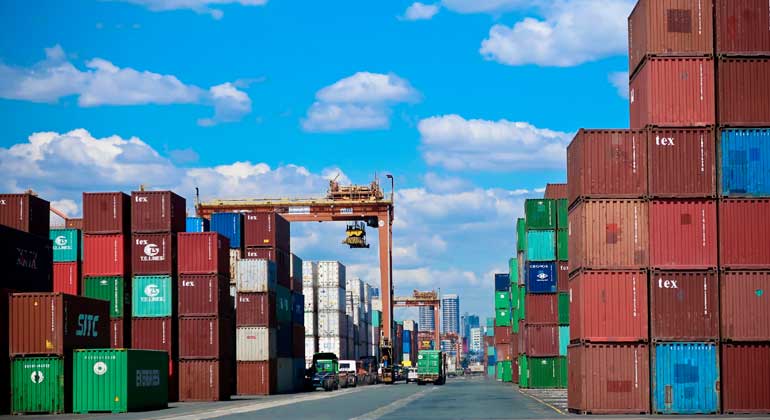
By Abigail Marie P. Yraola, Researcher
The Philippines’ trade deficit in goods narrowed to its two-month low in April, as imports and exports contracted by double digits to their lowest level in almost three years, the Philippine Statistics Authority reported on Friday.
The country’s trade-in-goods balance—the difference between exports and imports— reached a deficit of $4.53 billion in April. This indicates a decrease from the revised $5.10 billion deficit in the previous month and the $5.32-billion gap in the same period last year.
It was the slimmest trade gap in two months or since the $3.91-billion deficit in February.
The country’s trade balance has been in deficit for almost eight years (95 months) or since the $6.5-million surplus recorded in May 2015.
Total outbound sales of Philippine-made goods declined by 20.2% year on year to $4.90 billion in April, faster than the revised 9.1% drop in March and a reversal from the 6.2% growth seen in the same period last year.
April marked the fifth straight month of exports decline.
This was also the steepest in 35 months or since the 26.7% decline in May 2020 with exports receipts plunging to their lowest level in the same period with $4.54 billion.
Meanwhile, the country’s merchandise imports fell by 17.7% year on year to $9.43 billion in April, sharper than the 1.2% decline the prior month. This was also a reversal from the 29.1% growth in April 2022.
This drop in imports was the sharpest in 33 months or since the 20.8% decline in July 2020. The import bill that month, on the other hand, was the smallest amount in two months or since the $8.98 billion in February.
Makoto Tsuchiya, assistant economist from Oxford Economics Japan, attributed the drop in exports to declining external demand for Filipino goods due to the slowing global economy.
Capital Economics’ emerging Asia economist, Shivaan Tandon, said the biggest drag on exports came from a sharp decline in electronics exports.
“The pandemic-induced boom in electronics demand has turned into a slump since the second half of 2022,” he said in an e-mail.
He added that firms are saddled with high inventory levels as global consumer demand has shifted back to services from durable goods.
“On the imports side, we think the weakness reflects soft domestic demand as the reopening boost fades,” Mr. Tsuchiya said in an e-mail.
He added that this likely reflects continued shift of spending from goods to services.
“Lower fuel prices compared to a year ago also pulled down the nominal figure, and we think this will continue to be a drag on the headline growth.”
In the first four months, exports fell by 14.9% to $21.77 billion while imports also slid by 6.7% to reach $41.05 billion, way below the the government’s revised 1% and 2% growth targets this year for exports and imports, respectively.
This brought the trade deficit to $19.28 billion in the January to April period, wider than the $18.40-billion gap in the same period last year.
Outbound shipments of manufactured goods in April, which accounted for 79.4% of total exports, contracted by 16.5% year on year to $3.89 billion.
Electronic products, which made up 68.6% of the manufactured goods and more than half of total exports, declined by 17.9% to $2.67 billion.
About 43% of this came from semiconductors, which likewise dropped by 14.5% to $2.11 billion.
Meanwhile, orders of raw materials and intermediate goods in April fell by 18.9% to $3.56 billion. These accounted for nearly 40% of the total April import bill.
Imports of capital and consumer goods were valued at $2.80 billion (down 11.9%) and $1.79 billion (up 8.3%), respectively.
Mineral fuels, lubricants and related materials dipped to $1.25 billion from $2.18 billion last year, accounting 13.2% of the total.
China remained the main destination of Philippine-made goods in April as exports to that country amounted to $772.47 million, or 15.8% of the total exports that month.
Other top export trading partners include the United States which accounted for 14.6% or $713.65 million and Japan with 13.1% or $642.23 million.
“By destination, the decline was also broad-based, with main trading partners such as China, US, Japan, and Hong Kong all registering contraction,” Mr. Tsuchiya said.
“We maintain our position that Chinese reopening won’t provide much support for the exports, as the recovery in China will be focused on the services sector,” he added.
At the same time, China was still the main source of imports, accounting 23.9% of the total or $2.26 billion of the total import bill. Indonesia followed with an 8.7% share or $821.81 million and Japan with 8.5% or $800.58 million.
OUTLOOK
Mr. Tsuchiya foresees a bleak outlook for exports of goods if the current trend persists.
“We think the goods export performance will disappoint for the rest of the year, as we don’t look for a rapid turnaround in the IT cycle, while the global economy is set to slow further for the rest of the year,” he said.
Meanwhile, for imports, lower external demand and subdued business appetite for investment will lead to lower intermediate and capital imports, while normalizing consumption patterns will weigh on consumer imports for the rest of the year.
For Mr. Tandon, elevated interest rates and high inflation continue to take a toll on consumer demand in general.
“Given electronics account for the largest share of goods exports in the Philippines, and the downturn looks set to continue in the near-term, the outlook for goods exports remains bleak for the rest of the year,” Mr. Tandon said.
April trade deficit narrows to 2-month low
Source: Bantay Radio
0 Comments